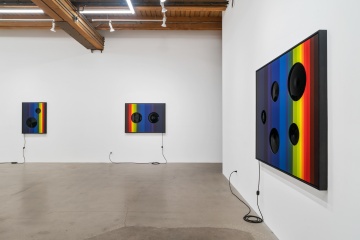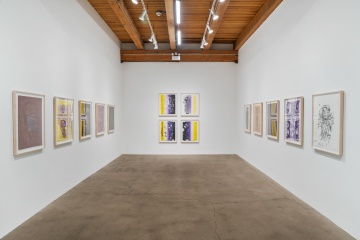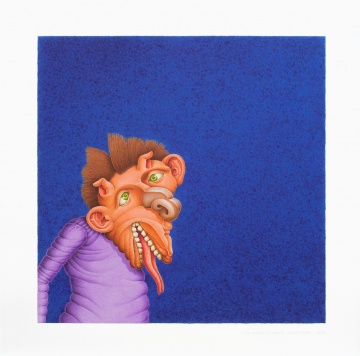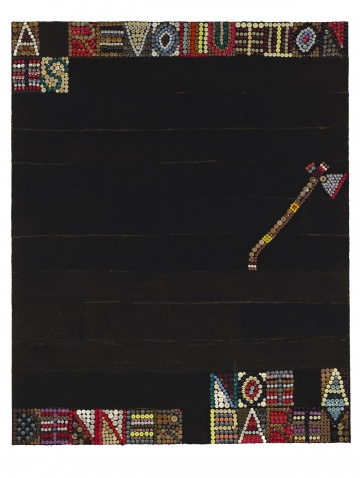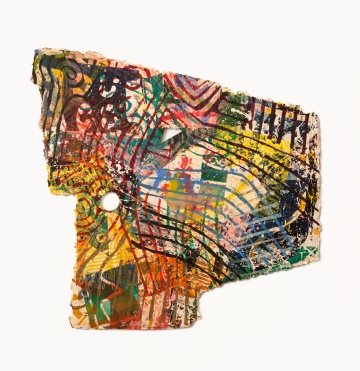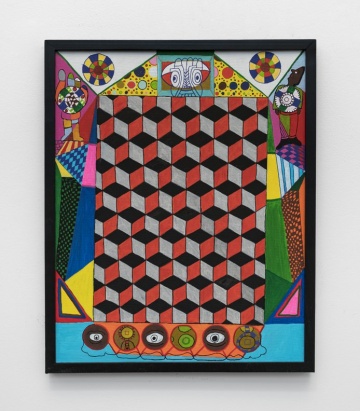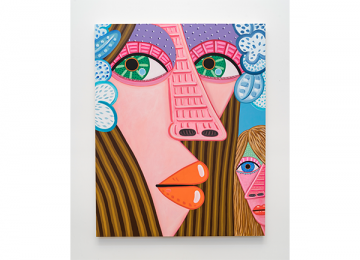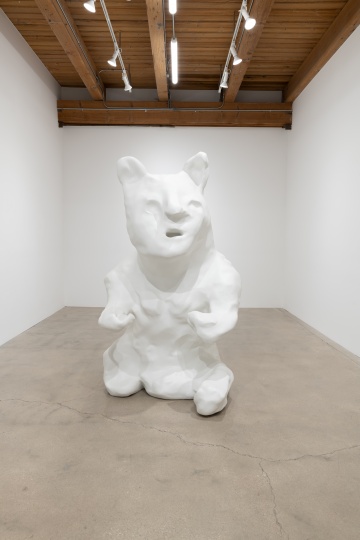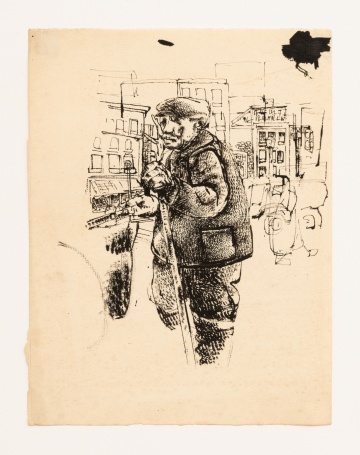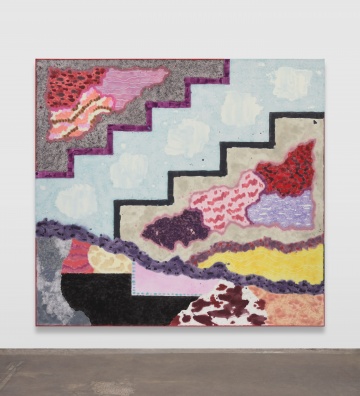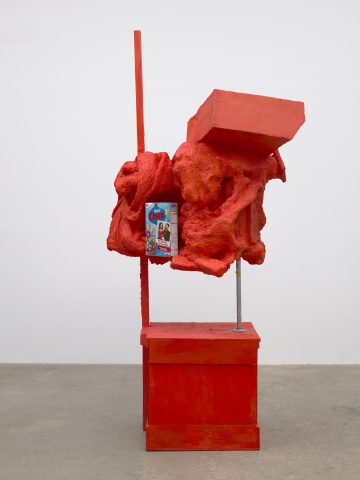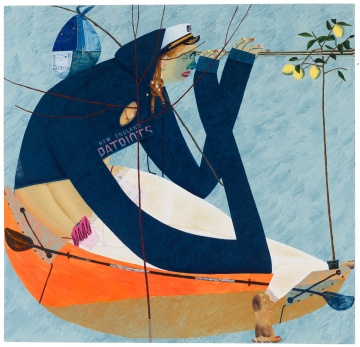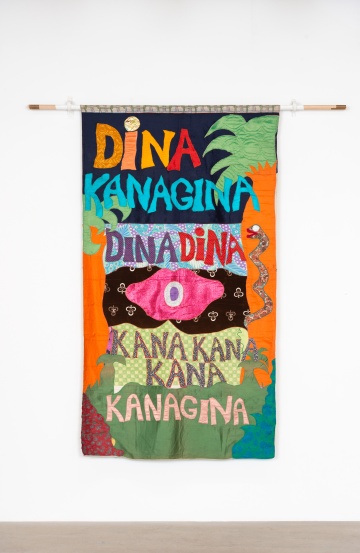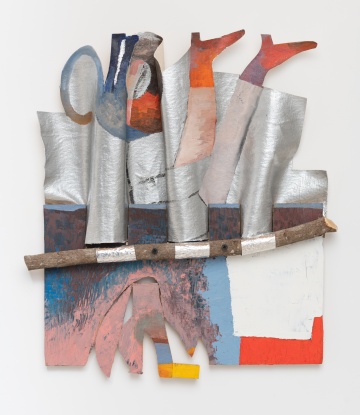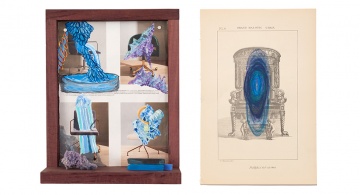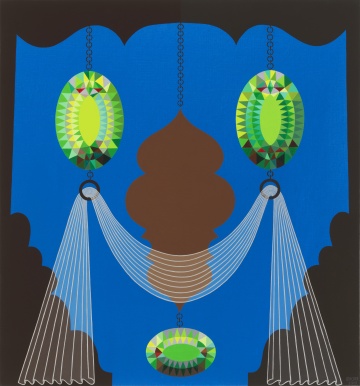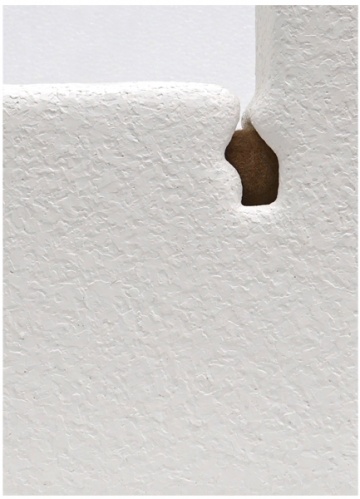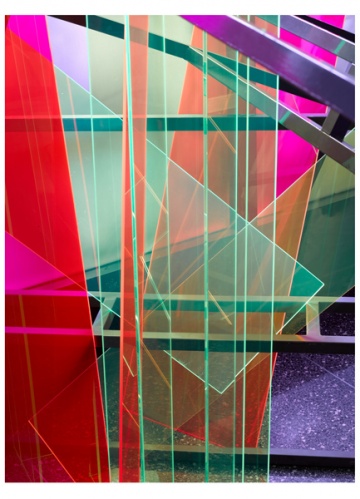Corbett vs. Dempsey
2156 West Fulton Street
Chicago, IL 60612
773 278 1664
Chicago, IL 60612
773 278 1664
Artists Represented:
Morris Barazani
Robert Barnes
Margot Bergman
Ellen Berkenblit
Peter Brötzmann
Brian Calvin
Emilio Cruz
Dominick Di Meo
Robert Donley
Ed Flood
Christina Forrer
Gabrielle Garland
Magalie Guérin
Philip Hanson
David Hartt
Arturo Herrera
Charline von Heyl
Dick Higgins
Thomas H. Kapsalis
Gina Litherland
Robert Lostutter
Josiah McElheny
Rebecca Morris
Albert Oehlen
Joyce Pensato
Sun Ra
Christina Ramberg
Celeste Rapone
Seymour Rosofsky
Arlene Shechet
Rebecca Shore
Lui Shtini
Diane Simpson
Cauleen Smith
John Sparagana
Omar Velázquez
William Weege
Richard Wetzel
Karl Wirsum
Christopher Wool
Jimmy Wright
Molly Zuckerman-Hartung
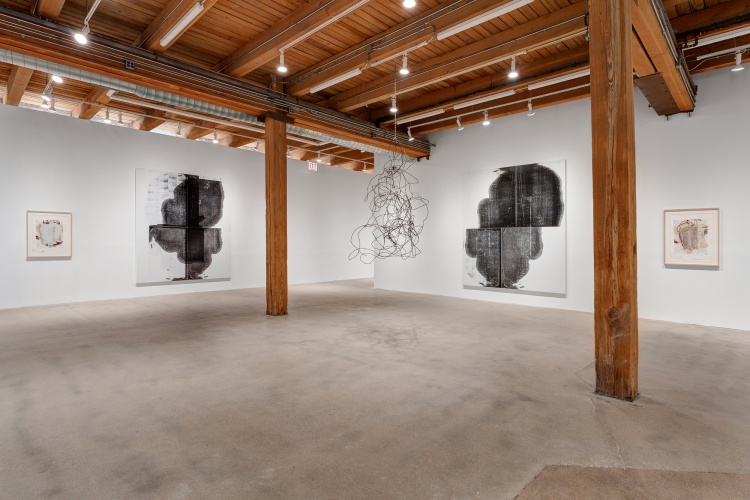
Installation view, Christopher Wool. Courtesy Corbett vs. Dempsey, Chicago. Photo Credit: Robert Chase Heishman, 2019
Josiah McElheny
From Red Black to Black, from Blue Black to Black
September 21, 2023 - November 4, 2023
Corbett vs. Dempsey is delighted to present From Red Black to Black, from Blue Black to Black, a suite of new works including a sculpture, an installation, and four paintings by Josiah McElheny. This is the artist’s third solo exhibition with the gallery.
Three questions:
What happens when one form of energy is changed into another?
What shifts when you expand the limits of the color spectrum?
What activates when a spectator is able to hear a color or see a sound?
The answers all have to do with the interrelated triad of transduction, spectra, and synesthesia. These are basic science concepts, but they are also metaphors for the act of transformation. A way of representing fundamental change, of imagining the mutable nature of objective reality, and how that might represent our optimal collective futurity.
In From Red Black to Black, from Blue Black to Black, McElheny offers six extraordinary meditations on these questions. Four wall-hanging works incorporate embedded hand-blown vibrating glass discs that transduce and resonate sound signals. These “singing paintings” amplify musical works by David Grubbs that were especially commissioned for these pieces, as were all the sounds in the show. A combination floor-and wall-based sculptural installation stretches a red-sheathed cable around the interior of the space, transporting a heartbeat-like, non-repeating, non-metronomic signal from a Serge synthesizer (the “People’s Synthesizer,” designed in 1972) to a drum-like cylindrical shell embedded with colored glass discs – vintage optical filters in a dazzling array of hues – the top of which transduces the sound by way of a white glass “drum head.” A major floor sculpture at the center of the exhibition is based on the Leslie speaker system best known from soul jazz organ groups; across intervals of silence the melody from a Baroque chorale alternates with the musical trainwrecks of progressively slowed-down harmony parts. Along with the sculpture’s spinning, doppler-effect inducing horn element, like the paintings its surface is marked with painted color spectra.
The sequence and proportion of these colors reflect McElheny’s profound engagement with 19th century explorations of chromatic spectra, in particular the work of French chemist Michel Eugène Chevreul. The title of the show refers to McElheny’s radical idea that the color black exists as an expanded infinite place at the beginning and end of the color spectrum. Unlike Sir Isaac Newton, who insisted that black does not exist as a part of light or color, or Johann Wolfgang von Goethe, who theorized that color only comes out of shadow – or blackness – as the opposite of light, and that black is not a color in itself, McElheny’s vision puts black at the core of real color, as a full-fledged component of the visible electromagnetic spectrum.
In From Red Black to Black, from Blue Black to Black, McElheny effectively decouples the spectral from the prismatic, so the selection, order, and proportionality of its elements is not predetermined. Spectrum as domain of conceptual invention and intervention, upending its rootedness in physics or optics. An aprismatic artifact of rigorous imagination.McElheny was inspired and challenged by the alternative methods – freedoms – investigated by Milford Graves and Joe McPhee. These musicians have taken as building blocks mutable rhythms and microtonality rather than regular time and the diatonic scale. Grubbs’s sound source for the four paintings is a slide guitar, with which he patiently explores the timbral effects of microtonal variation. McElheny approaches the notion of color spectrum similarly, as a flexible system with constituent elements to be stretched or compressed, perhaps to a point of infinite possibility: a far more expansive notion than gradation guided by an axiomatic set of rules. Seeking a connection between the musical and visual expression of this alterity, the exhibition gradually metamorphosed from the narrower concept of transduction into something more inclusive, a capacious sense of chromesthesia in which sound evokes color and thereby stimulates new vibratory realms.
A catalog with a CD featuring a new sound piece by David Grubbs based on the works in the show is forthcoming.
Gregg Bordowitz
Tetragrammaton
September 21, 2023 - November 4, 2023
Corbett vs. Dempsey is honored to present Gregg Bordowitz, Tetragrammaton, featuring a selection of recent monotypes. This is CvsD’s first exhibition with Bordowitz and is the artist’s debut in a commercial gallery.
"The tetragrammaton is an ineffable, unpronounceable four-letter Hebrew word, the name of G-d in Judaism that spells creation into existence daily,” says Bordowitz. “It is never uttered and appears only in written form.” In these monotypes, Bordowitz concentrates on the letters of the tetragrammaton: yodh, he, vav, and he. Writing them over and over, every line drawn from a shape in one of the letters – an action determined by a numerological system – he arrived at a series of abstractions, dense, energetic and evocative, each one unique. He describes the prints as concrete poems. “They come out of an abiding interest in contemporary visual poetry and also a centuries-old meditational practice of rearranging the letters in one’s mind.” Bordowitz cites key affinities with concrete poets Gerhard Rühm, Mary Ellen Solt, and b.p. nicol, as well as a deep influence from the calligraphic work of Ben Shahn.
Renowned as an activist artist, writer, and teacher, best known for his video and performance works, Bordowitz began his artistic life four decades ago as a painter. The Tetragrammaton prints are a return to working in 2-D visual media, evolving organically out of an active drawing practice that he formalized in this extensive body of printworks. In preparation for an exhibition at the University of Buffalo Art Galleries in 2021, Bordowitz began working with master printmaker Marina Ancona at 10 Grand Press in Brooklyn. He initially experimented with images in gray scale, then purple, eventually other colors, and expressing a desire to work with a “rainbow roll” in honor of Pride Day, he instigated a subseries using the color spectrum of the non-binary flag. “In Jewish mystical traditions, G-d has both masculine and feminine sides and is not anthropomorphized, in fact not depicted at all, so is all genders and no gender,” the artist explains.
Ever respectful, Bordowitz emphasizes that he undertook this new body of work with the utmost sincerity, care, and respect for the Jewish traditions around the tetragrammaton. With a religious childhood and educated orthodox, Bordowitz’s work has been permeated with Judaism, Jewish culture and Jewish humor. “There has always been Jewish content in my work, in every area, including the videos, as well as the recent performances and book titled Some Styles of Masculinity. In that work, I conjugated Jewish identity with other aspects of myself – queer, pinky-left.” In Tetragrammaton, Bordowitz extends his personal journey as an artist, writer and poet, combining these activities using a method that is both systematic and expressive, private almost to the point of hermeticism and publicly vibrant with a joyful, subversive twist.
Omar Velázquez
The Flood
June 23, 2023 - August 5, 2023
Corbett vs. Dempsey proudly presents The Flood, an exhibition of new paintings by Omar Velázquez. This is the artist’s second show with the gallery.
The vivid paintings of Puerto Rican artist Omar Velázquez (b. 1984) inhabit an intense, psychological space. A panoply of loaded images—mixing environmental, political, spiritual, and historical dimensions—bristle with information yet retain a latent aura of mystery. As with past work, in which objects and animals have figured prominently, Velázquez’s new body of larger-scale canvases expands the range of birds and reptiles to include a veritable herd of horses. These are not heroic stallions or idealized equestrian icons; they are weary, malnourished, and overburdened, showing the stress of life in a supposedly idyllic land. Underneath sumptuous paint application and brilliant use of color, Velázquez submerges a vast network of allusions. Faces appear on the surface of stones like codes or secrets—runes or mere graffiti. Stacks of wildlife, rocks, and various articles resemble talismanic sculptures or cairns: one canvas features a white horse saddled by a live alligator and portable speakers. The biblical idea of the flood is at the core of Velázquez’s supercharged scenes in which calm messengers portend ominous signs; flooding is also a real fear for contemporary society, particularly for an island like Puerto Rico. Water is present in every painting, akin to a constant mental state for the artist: “Being an islander, there is always water,” he says. “Our borders are made of water. But it’s not the same water in every case.” From ocean blue to mud brown, these diluvial images hearken to recent environmental catastrophes on the island, such as Hurricanes Maria and Fiona, as well as a sequence of recent earthquakes. Velázquez presents a deluge of contradictions: fire blazes on an island paradise; ubiquitous water is nowhere to be found; and a fossilized turtle balances a stone and vulture on its carapace like a totem of eternity. Things, ever-changing, remain stubbornly the same.
Omar Velázquez received his MFA from the School of the Art Institute of Chicago. He was the subject of a solo exhibition at the Museum of Contemporary Art, Chicago (2020-21), and has had one-person shows at the Museo de Arte de Puerto Rico (2015), and the National Museum of Puerto Rican Arts & Culture, Chicago (2013).
Thomas H. Kapsalis
Nine Decades
June 23, 2023 - August 5, 2023
Corbett vs. Dempsey is proud to present Nine Decades, a memorial survey of painting and sculpture by Thomas H. Kapsalis.
A graduate of the School of the Art Institute of Chicago (SAIC), where he went on to teach for more than 50 years, Thomas H. Kapsalis (1925-2022) was one of the most beloved figures in the history of Chicago art. The combined Kapsalis class rosters are a panorama of Chicago artists, including a who’s who of the Hairy Who. In his work, Kapsalis remained committed to a modernist concept, albeit one inflected by his unique combination of formalism and humor. A decorated WWII veteran and prisoner of war from the Battle of the Bulge, Kapsalis responded to the U.S. involvement in Vietnam by removing color from his work. Nine Decades presents a survey of the artist’s career encapsulated in nine works, each drawn from a different decade of his painting and sculpting, starting with a small, black-and-white totemic abstraction from 1949, and ranging through brilliant, biomorphic canvases of the ‘50s and ‘60s, including “Danger Ahead” (1959), an abstract work with a face in it (hence: danger, a head). His 1971 painting “Three Cubes” comes from the black, white, and gray Vietnam period; the works on view from the 1980s, ‘90s, ‘00s, and ‘10s, demonstrate the artist’s persistent engagement with geometric abstraction and periodic revisitation of organic, sinuous forms. A work from the present decade demonstrates Kapsalis’ steadfastness in his studio practice, even as he headed into his late nineties. Few artists have the longevity and tenacity to allow such a sampling. Kapsalis was rare in many ways, as an artist, and as an uncommonly inspiring teacher. Parallel to this exhibition, David Salkin Creative will show some of the delightful handmade teaching materials that Kapsalis crafted for his courses at SAIC, including color chart paintings that were also his sly way of reintroducing color into his work as the U.S. began to pull out of Vietnam.
Robert Lostutter
Songs of War
May 5, 2023 - June 17, 2023
Corbett vs. Dempsey is pleased to present Songs of War, an exhibition of new watercolors and graphite drawings by Robert Lostutter. This is the artist’s fifth solo show at CvsD.
Channeling the extreme angst of today’s global political and social environment, Robert Lostutter (b. 1939) presents a terrifying vision of contemporary humanity in a shocking new body of work. Wielding the same incredible craftsmanship and care that have been trademarks of his hand since the 1960s, when he first emerged on the Chicago art scene, Lostutter introduces an element of grotesquerie into his latest delicate watercolors and drawings, taking a brutal, quite breathtaking leap into abjection barely presaged by his earlier works. These figurative portraits—situated in sumptuously rich monochrome or blacker-than-black backgrounds—depict humanoid creatures with protruding jaws, wayward teeth, lolling tongues, exposed brains, and lappets of extra skin. While Lostutter’s earlier figuration featured hybrids of humans and birds or flowers, or tightly bound torsos intimating BDSM, the present disfigured subjects are less hybrid than they are inbred; the intimated is made explicit with the latent utopianism of his work suddenly turned in on itself—a clear indication of the artist’s disgust at our current social atavism. With a title evocative of Winslow Homer’s work picturing scenes from the American Civil War, Lostutter’s series dares to caricature bloated and malevolent legionnaires in an unblinking manner. Like a speculative fiction of New Objectivity—Otto Dix on steroids—these men populate a bleak contemporaneity, staring blankly into the social abyss through eyes as elegantly composed as a pencil or paintbrush can manage.
Jeff Perrone
A Revolution Is Not a Dinner Party
May 5, 2023 - June 17, 2023
In the north gallery, Corbett vs. Dempsey is honored to present Jeff Perrone: A Revolution Is Not a Dinner Party, a selection of seven new canvas works. This is Perrone's second solo show at the gallery. As this notice goes to press, CvsD is deeply saddened to convey news of Perrone's untimely death.
Expanding upon the charged, text-centric corpus he explored for the last two decades, Jeff Perrone (1953-2023) recently scaled up his work and introduced imagery into the newest group of canvases. Onto each substrate, the New York-based artist laid down strips of mud cloth, a traditional Malian textile. Some of the cloth remains in its original state, dyed with mud and plant parts; in other cases, Perrone re-dyed the fabric in new colors such as hot pink, jet black, or denim blue. Columns or rows of lettering, articulated in a brilliant array of vintage and cheap contemporary buttons sewn onto the mud cloth, spell out text—the words sometimes running together without spaces or forged from negative space, challenging immediate interpretation. In most works, buttons are also arranged into images consisting exclusively of weapons: arrows, a tomahawk, bombs, a guillotine, and a machine gun. Drawing phrases from a variety of different sources, including Chairman Mao ("a revolution is not a dinner party"), Mahatma Gandhi ("poverty is violence"), Gustave Flaubert ("hatred of the bourgeois is the beginning of wisdom"), Franz Fanon ("we revolt because we cannot breathe"), and James Baldwin ("innocence is the crime"), Perrone manages a blunt face-off between image and text, juxtaposing adages with simplified icons of weaponry. These images are ambivalent in their invocation of power, suggesting either revolutionary radicality, a literal "seizing of the means of production," as one text—augmented by an image of a Kalashnikov rifle—declaims, or a savage defense of the status quo, as in the case of the guillotine pitted against Gandhi's quote. Traces of Perrone's early association with Pattern & Decoration—a movement he helped define and theorize in articles and reviews he published as a regular contributor to Artforum in the 1970s and '80s—linger here in the presence of ornament and craft. His visual interventions, including the ingenious layout of the letterforms, the appearance of representational motifs, and the bruising power of the words, could be understood as subverting some principles of P&D, but Perrone was never satisfied with simple dichotomies. His work long sought to confront assumptions, rooting them out playfully and ruthlessly. Perrone rendered polarities moot in the profound resonances of his canvases: the glint of the buttons and the matte of the mud cloth, the humming energy emerging between the elegance of their construction and the tough truths of their texts.
Sam Gilliam
Driftless
March 17, 2023 - April 29, 2023
Starting in 1972, at the Jones Road Print Shop and Stable, located in a dairy barn in the area of southwest Wisconsin known as the Driftless, renowned painter Sam Gilliam began what would be a career-spanning relationship with master printer and printmaker Bill Weege. Driftless presents the fruits of their partnership, which made use of all manner of print techniques—known and unknown, sometimes involving papers that were handmade in the studio or parts that were hand-sewn together, a specialty of Weege's—and many unusual and innovative painting methods. Working at Jones Road, Tandem Press, and later at Weege's home studio, Gilliam made brilliant, vividly colored, exploratory abstractions. Gilliam and Weege were relentless experimenters from the very first print they made together, which was made by Gilliam painting directly onto the bed of an offset proofing press. Gilliam would often propose a possible way to make an artwork or an intended result and Weege would figure out a way to do it. This included such unorthodox ideas as leaching paint onto substrates that had been buried in the earth or using a tractor to drag loose canvas across fields strewn with paint and ink, both possible in Weege's rural printmaking compound. The two artists collaborated every summer for 45 years, with Gilliam traveling to Wisconsin and setting up shop, sometimes with his family. One of their final collaborations in the Driftless resulted in the sweeping draped work Yves Klein Blue that Gilliam hung above the entrance to the Central Pavillion in the Giardini at the Venice Biennale in 2017. Gilliam had been the first Black U.S. representative in Venice in 1972 (two years earlier, Weege had exhibited at the Biennale and created a scandal by handing out freshly made "Impeach Nixon" prints). Known especially as a pioneer of unstretched canvas, Gilliam worked for seven decades in a staggering variety of media. Based throughout his career in Washington, D.C., he was immensely influential on a national and international level from the time of his important 1969 solo exhibition at the Corcoran until his passing in 2022, at the age of 88. Over the years, Gilliam acknowledged the central significance of his working partnership with Weege, with whom he traveled the world, mounting presentations supported by the U.S. State Department. Speaking of their exploratory working methods, Weege once said: "The great thing about Sam Gilliam is that a lot of the stuff that we produced, or I helped produce, I’d go: 'This is not gonna make it.' And he would always have a way of staging it that became beautiful. It was just such a treat to have that happen with things that you thought you were never going to be able to save. And it always turned out well." In Driftless, CvsD presents a selection of editioned printworks by Gilliam as well as unique monoprints and paintings using print techniques, dating back to his very first collaboration with Weege, with special attention to the early years of their work together in the 1970s. In addition to the prints, the exhibition includes a large diptych from the late 1970s that hung with pride of place in Weege's studio.
Jimmy Wright
Down Home
March 17, 2023 - April 29, 2023
In the late 1980s, working at the Lower East Side Print Shop near his home in Manhattan, Jimmy Wright created a series of monotypes based on tintypes and other early photographs of his family and their rural Kentucky environs. Wright settled in New York in the early 1970s and spent that decade drawing from scenes he witnessed in the city's underground gay clubs and bathhouses. The buttoned-up scenes of his ‘80s prints were the exact converse of those explicit drawings, exchanging an everything-bared sexuality for the deeply repressed carnal energies of a strictly religious upbringing. But this converseness turns out to be a kind of complementarity, the overt and the covert as two sides of the same Kentucky coin. Evoking and interrogating the nostalgic quality of family pictures, Wright made use of theme and variation, putting the haunting portraits through a series of modulations—shifting colors, always pale and washy, almost disappearing in front of our eyes, like the Wright family's version of the agrarian south. Some of the works utilize inset cameos, compiling different portraits and scenes into composite images, like family albums, while others gently retouch the delicate, cloudy, layered inks with more saturated pastels, refocusing and inflecting them. Wright assembled two vivid sets of smaller pages into artist books, with accordion constructions, one of which is included in and lends its name to the exhibition. Down Home is accompanied by a special 'zine featuring images of the monotypes and some of the source materials that inspired them.
Roscoe Mitchell
Keeper of the Code: Paintings 1963-2022
January 20, 2023 - March 11, 2023
Corbett vs. Dempsey is pleased to present Roscoe Mitchell, Keeper of the Code: Paintings 1963-2022. This is Mitchell’s first exhibition with CvsD.
Roscoe Mitchell (b. 1940) has been a leading figure in the performing arts for over 50 years. Keeper of the Code is the first solo exhibition to spotlight his work in the visual arts. Born and raised in Chicago, Mitchell formed the Roscoe Mitchell Art Ensemble in 1966, featuring Lester Bowie and Malachi Favors. Three years later, adding Joseph Jarman, upon their departure to Paris for a two-year sojourn the group transformed into the collective interdisciplinary troupe called the Art Ensemble of Chicago. By that time Mitchell had already recorded the first LP of music affiliated with the Association for the Advancement of Creative Musicians (AACM), Sound (Delmark, 1966), and he had joined forces with St. Louis trumpeter Bowie for Numbers 1 & 2 (Nessa, 1967), which featured a painting by Mitchell on its cover. Indeed, Mitchell had been painting since 1963, and he continued on and off into the heyday of the Art Ensemble and through a hyperproductive sequence of decades of solo music, improvised encounters, and music for Mitchell-led ensembles. The pandemic afforded Mitchell time off-road in which he began painting very avidly again. This exhibition surveys his work from the most recent canvases—including a series of compositionally complex four-by-four foot works—all the way back to the beginning, when Mitchell was a promising young saxophonist and ambitious autodidact painter. A large selection of recent works, executed since 2018, includes the painting “The Code 3,” its diamond-mosaic pattern surrounded by hip glyphic figures including the titular keeper. These delightfully playful, jubilantly colorful canvases sport various repeated motifs and themes—custodians of codes and keys, time keepers and ticket takers, figures known as “floaters” and “wavers,” and another persona called “the watcher.” Alongside these imagistic works, interpenetrating them as well, are all sorts of approaches to abstraction, from organic masses of circles that might recall Aboriginal art and warped checkerboards to more rigidly structured geometry and color sequences. In the gallery’s north space, CvsD has gathered Mitchell’s historical works dating back to 1963, including the cover painting from Numbers 1 & 2, and the riveting piece that graced the Art Ensemble’s 1985 LP The Third Decade. In addition to the paintings, Mitchell is installing a new incarnation of his legendary percussion set-up known as “The Cage,” which directly bridges the musical and visual in his capacious artistic imagination.
Concurrent with the exhibition, in the Vault, CvsD presents Wendy Nelson, The Roscoe Videos, a selection of five films of Roscoe Mitchell in varied performance contexts, including international concerts and intimate home footage. Amongst the latter are duets between Mitchell and his dog Shuggie and sequences shot in Mitchell and Nelson’s basement studio featuring a highly refined version of Mitchell’s percussion set-up. Wendy Nelson is a multimedia artist based outside Madison, Wisconsin.
Keeper of the Code is accompanied by an in-depth 140-page full-color catalog reproducing over 100 of Mitchell’s paintings, with an interview by John Corbett. A book-launch event will also take place on the day after the exhibition’s opening reception, at 2 pm, Saturday, January 21, at Seminary Co-op Bookstore in Hyde Park, with a conversation between Corbett and Mitchell.
The opening reception for Keeper of the Code runs from 5–7 pm at CvsD on January 20, 2023.
At 7 pm on the same evening, Roscoe Mitchell will present a special concert in the gallery with his SPACE trio, featuring Mitchell, Scott Robinson (reeds), Tom Buckner (baritone voice), and special guest Robert Dick (flutes). The concert will be 45 minutes in length, there will be no seating, and space is quite limited, so please plan accordingly.
Brian Calvin
Brian Calvin: Something or Other
November 18, 2022 - January 7, 2023
For the final show of 2022, Corbett vs. Dempsey is delighted to present Brian Calvin, Something or Other, an exhibition of new paintings and drawings. This is Calvin’s fourth solo exhibition with CvsD.
Brian Calvin’s assiduous relationship to the figure borders on the obsessive—since the 1990s, he has explored approaches to faciality from every angle, asking for a full list of the face’s constituent parts, investigating how they may be combined and situated, what happens when there are too many or too few, what productive confusion occurs when faces are combined or seem to be combined. In a group of new canvases and works on paper, Calvin has allowed the images to move in unexpected directions, accessing Cubism through the back door of Surrealism, expressing the otherworldly by way of the everyday, the multiple point perspective by means of a singular point of view. Along the way, the California painter has invented several signal icons—spectral irises, red-hot lips, and hyper-stylized, ventilated noses, for instance—which function both as features on special people and as rationales for extraordinary painting. His command of bright color is an important factor in this body of work, as is the play of flatness and implied deep space—giant Moai-like heads that fill the whole frame and small heads that peer from a distance. Something or Other introduces eight large canvases, four small canvases, and a selection of drawings in graphite or pastel. All sumptuously executed, all deliciously weird.
Margot Bergman
Grover's Corners
June 10, 2022 - August 6, 2022
n the north gallery, CvsD is proud to present Margot Bergman, Grover’s Corners. This is Bergman’s sixth one-person exhibition with CvsD and unveils her first large-scale sculpture.
Margot Bergman has long held her work to the utmost level of frankness. Her paintings have eschewed allusion or euphemism in favor of the forthright, the penetrating, the uncomfortable, and the illuminating. But what does unflinching honesty look like in an era of widespread uncertainty? Taking its title from the setting of Thornton Wilder’s 1938 play Our Town, the exhibition Grover’s Corners unveils a seven-foot tall fiberglass figure. Entitled “Warrior,” this imposing work absorbs, reflects, refracts and projects myriad contradictions of our contemporary landscape.
The sculpture’s form originated in a series of small-scale porcelain ceramics that Bergman created in 2010, a group of animal and human-animal hybrids with bright red glazes that she collectively called the Red Hots. Although rigorously faithful to its precursor, this Red Hot has been transmogrified into a new and much more imposing creature, not only in stature but also in range of associations, with a sensuous, creamy patina more like a classical Greco-Roman bust than a spicy candy. In the sculpture’s complex surface topography Bergman offers an equally rich, multivalent image, a cipher more than an avatar, the embodiment of a range of dichotomous or contradictory realities – human face with animal features, uffish but vulnerable, a square-jawed mesomorph with arms reaching out but no hands to grasp, powerful and also somehow urgently poignant. It conjures something at once frightening and vulnerable – a kind of brokenness, a beautiful ambiguity that invites empathy but also pushes the viewer away. Like the dialectical relationship between quotidian daily routine and the profound finitude of death in Wilder’s play, Bergman’s sculpture offers a forceful meditation on what it means to live within that set of contradictions. A perfect representative of Our Town, circa 2022.
Magalie Guérin
hard green
June 10, 2022 - August 6, 2022
Corbett vs. Dempsey is delighted to present hard green, an exhibition of new paintings by Magalie Guérin. This is the artist's third solo show at the gallery; Guérin was also the subject of a Big Dig online presentation in 2020 titled The Lekeitio Drawings.
Born in Montréal, Canada, now based in Marfa, Texas, Guérin has continued to prod and push her highly personal approach to abstract painting. The latest body of work offers a remarkable new vision of the torqued forms and multiplicitous surfaces of her recent paintings, executed at a larger scale ranging up to 3 x 4 feet. At this size, additional area functions as a vehicle for opening up and exploring space, for spatial play – her adventures in foreground/background relationships, figure-ground issues, and closed/open composition are as ever daring, but here are even more so, complexity and stillness vs. implied motion being consistent features. Guérin is a master of recurrent shapes, rotating or flipping forms to render them afresh and unrecognizable, the same way a serial composer might use retrograde inversion to revitalize a tone row. She repeats and deconstructs with glee, turning self-restriction into a cornucopia of new discoveries. The most obvious development in hard green has to do with Guérin's paint application, which is looser and more painterly than in the past. This gives the canvases a different resolution in terms specifically of their overall vibration. Their architecture jostles up against the manner of their execution, creating a halo of static electricity. "It feels like a structure that just got shaken up," says Guérin. Indeed, this group of new paintings, as well as a small selection of related drawings in the front office, has a palpable frisson, a restless inventiveness that seems to undo its laces even as it ties them up.
Gina Litherland
Gina Litherland: Braids of the Past
April 29, 2022 - June 4, 2022
"Braids of the Past," an exhibition of recent paintings by Gina Litherland. The artist has been exploring a personal approach to image-making for over four decades, interweaving strands drawn from mythology, literature, film, folklore, and natural history, in a visual style that connects her with Northern Renaissance portraiture and Magic Realists.
John Heliker
John Heliker: Drawings of the 1930s and 1940s
April 29, 2022 - June 4, 2022
"Drawings of the 1930s and 1940s," featuring works by John Edward Heliker (1909-2000). This rare exhibition of the artist's work is drawn from a small collection of works on paper from a prime period early in his career, when he was drawing and sketching actively alongside Social Realists including William Gropper and Ben Shahn.
Rebecca Morris
Rebecca Morris: #29
March 18, 2022 - April 23, 2022
Corbett vs. Dempsey is pleased to present #29, an exhibition of new paintings by Rebecca Morris. This is Morris's third solo show with the gallery. Additionally, she has been the subject of a 2020 Big Dig online exhibition, and a 2018 CvsD Condo presentation hosted by Bortolami in New York City.
Rebecca Morris is fiercely committed to abstract painting. For the past 21 years her paintings have borne numerical titles to avoid adding extraneous verbal imagery or associations to the paintings themselves. The work is what it is, which is radiant, challenging, and satisfying. Keeping in this vein, #29 is Morris's twenty-ninth solo exhibition, continuing her investment in the possibilities for metallic delineated grids, angular geometric shapes, vibrant washes of color, checkerboard fields, and textured surfaces that jostle for space.
The devil is in the details in Morris works, which always richly repay attentive viewing. The eight large-scale paintings and one smaller canvas included in #29 move into new terrain from past series of paintings in the myriad ways they grapple with transitions. Harder borders now contain ambiguities they might previously have abjured, while in other places the transitional features are bold but grapple with increasingly complex implications of space. Passage from one area into another is a magical formulation in these paintings – for instance the way the irregular bright silver edge on Untitled (#08-21) sits atop another darker interior silver border, creating a mysterious two-step transition into the thinly-brushed black matrix at the composition’s center, within which vivid fragmentary parts float like a conglomerate puddingstone. In places that one might anticipate a sharp transition, like between the puzzled-together parts of Untitled (#02-21), Morris thwarts the obvious by using a soft edge, generating lots of lustrous painterly energy where the tectonic plates meet.
Morris is acutely aware of how expectation functions in the experience of viewing a painting, the subtle ways that pattern and repetition, rupture and interruption, the general play of continuity and discontinuity, and even literal framing devices conspire to instigate formal drama. Seven of these paintings feature beautiful low-relief impasto metallic lines that grid diaphanous space, articulate a border—or both. Untitled (#01-21) and Untitled (#11-21) interrogates a checkerboard pattern, introducing complicated brushwork into its seemingly negative spaces.
This is the largest group of Morris paintings that CvsD has yet shown, among them the largest paintings as well, facilitated by the ceiling height in the ground-floor space that the gallery has inhabited since 2019. Size is essential to certain canvases, as Morris explained in her Big Dig interview, where she laid out core concerns specific to the oil paintings: “extreme scale, detailed compositional strategies, and very determined color relationships.” The largeness of some of these works – the tallest is nearly ten-feet in height – permits the intense particularity of the colors and the complexity of the compositions to phase-shift from being a discrete object of observation into a phenomenon of vibratory immersion. These are somatic paintings. Within the expanse of a large canvas, minute incident and casual gesture gain significance, drawing the eye and mind deep into their domain of fascination.
Emilio Cruz
Inter-Planetary Slavery Paintings and Fiberglass Sculpture, 1970 - 1979
January 21, 2022 - March 12, 2022
Rachel Harrison
Rachel Harrison: Assorted Varieties
November 19, 2021 - January 8, 2022
Corbett vs. Dempsey is pleased to present Assorted Varieties, an exhibition of new work by Rachel Harrison. This is the gallery's first solo show with Harrison and the artist's first gallery presentation in Chicago.
In Assorted Varieties, Harrison unveils four major sculptures and three wall works. Of these large-scale pieces, three are in theory monochromatic – red, blue, and yellow. However, their variegated hues almost chide the idea of the monochrome, revealing a subtle pandemonium of shades and temperatures residing in craggy surfaces, torqued volumes, and inset objects. The wall works roughly map onto the color scheme of the sculptures, recast in different media – a framed set of post-it notes, an enigmatic abstract photograph (titled Photograph), and a blown-up screen grab of a frozen cherry pie with associated Tweet. Everything in Harrison's artistic ecosystem is buzzing with latent meaning – nothing is arbitrary, and nothing is obvious.
Since emerging on the international art scene in the 1990s, New York-based artist Rachel Harrison has built a critically incisive oeuvre consisting of work in various media. The subject of an acclaimed survey at the Whitney Museum of American Art in 2019, Harrison is most widely known for her masterful and irreverent sculptural work, which incorporates an ingenious formal sense within an apparent (but illusory) defiance of formalism. As art historian David Joselit has succinctly written, she "makes sculptures that defy description." The work is sensuous and strategic, serious and uproarious, self-referential and wildly omnivorous, ranging across historical points of reference drawn from both fine art and popular culture.
Celeste Rapone
Celeste Rapone: Controlled Burn
October 16, 2021 - November 13, 2021
Corbett vs. Dempsey is delighted to present Controlled Burn, an exhibition of twelve new paintings by Celeste Rapone. At CvsD, Rapone has been the focus of an eponymous Big Dig virtual presentation in 2020 and Everlast, a two-person exhibition with Betsy Odom in 2018. Controlled Burn is her first solo show at the gallery.
In a group of brand new canvases, Rapone opens up the space in her detailed compositions, situating figures in an architectural or natural scene. Still figurative and populated by a range of evocative characters, they are now less claustrophobically compressed, the settings providing a theatrical context for morphological feats, sly mass-cultural references, and luscious paint application. Rapone started work on the paintings in this exhibition in what she candidly calls "the clusterfuck of January, 2021" with no specific trajectory in mind, but over time they revealed themselves to be more about painting itself than anything thematic or topical. Where she has often approached painting as a chain process, a finished piece suggesting the direction for the next one, in this case each canvas took its own journey and gradually became its unique, monadic self, feeding less off its predecessor than off the intense energy of the time and formal and technical problems gyrating in Rapone's head. Among the diverse, dazzling results are the largest paintings she's ever made, a trend upward in scale that continues at present, as well as some of the most daring and hilarious images in her opus.
Celeste Rapone (b. 1985, New Jersey) received her BFA from the Rhode Island School of Design in 2007 and her MFA from The School of the Art Institute of Chicago in 2013, where she is now an adjunct professor in painting and drawing. Her work has been exhibited at Josh Lilley Gallery (London), Marianne Boesky Gallery (NYC), Zidoun-Bossuyt Gallery (Luxembourg), Roberts Projects (LA), Steven Zevitas Gallery (Boston), Julius Caesar (Chicago), The Hyde Park Art Center (Chicago), the Georgia Museum of Art (Athens), and Monya Rowe Gallery (NYC). In addition to her upcoming solo exhibition with Corbett vs. Dempsey, her work will also be included in ICA Boston's exhibition, A Place for Me: Figurative Painting Now on view from March 30 - September 5, 2022. Her work has been featured in New American Paintings, Newcity, The Chicago Tribune, The Georgia Review, and she is a 2018 recipient of a Pollock-Krasner Foundation Grant. She lives and works in Chicago, IL.
Moki Cherry
Moki Cherry: Communicate, How?: Paintings and Textiles, 1967 - 1980
September 3, 2021 - October 9, 2021
Corbett vs. Dempsey is pleased to present Moki Cherry, Communicate, How?: Paintings and Tapestries, 1967-1980. Following Blank Forms’ exhibition in New York, which took an in-depth look at the Don and Moki Cherry partnership, Communicate, How? places the spotlight squarely on Moki, concentrating on her masterful tapestries and playful canvases, never separating them from Don’s presence, but inviting a long overdue critical appreciation for Moki’s artistry on its own terms. This is the largest historical exhibition of Moki Cherry’s works to be mounted in the U.S. and will be on view September 3 – October 9, 2021.
In Communicate, How?, CvsD has assembled a selection of Moki Cherry’s most significant works, all of them drawn from the schoolhouse in Sweden where the family archives still reside. These include major tapestries that were used in performance and several that functioned as announcements for Organic Music Society events or other performances. Among these is a banner from the first gig for which Moki made a tapestry, as well as a marvelous silken marquee for a weekend festival at Ornette Coleman’s loft. A group of modestly scaled paintings, some of them shown in early Swedish exhibitions, suggest Moki’s uninhibited, surrealistic use of imagery, often centering on the female figure. These smaller works offer a key to her later tapestries, showing how she constructed her Thangka-like compositions piecemeal out of iconic fragments. The show also includes a ceiling-hanging soft sculpture that was part of Utopias and Visions, 1871-1981, an exhibition at the Moderna Museet in Stockholm in 1971, in which the Cherry family lived in a geodesic dome in the museum for three months; this extraordinary work has not been shown since that time. One of Don’s incredible Moki-designed shirts and several of her poster designs executed on paper round out the presentation.
Moki Cherry (1943-2009) was raised and educated in Sweden, where she worked as a fashion designer in the early 1960s. In 1963, she met Don Cherry, the legendary free music trumpeter, and changed the trajectory of her artistic practice forever. As a couple, Moki and Don worked together on building a utopian vision of art and music, eventually establishing Movement Incorporated, also known as Organic Music Society, a troupe with variable membership that drew together music, image, and dance, with costumes and stage sets created by Moki. Her work in this fecund period included designing posters and flyers for events – sometimes made as increasingly elaborate tapestries – as well as inventing most of Don’s signature outfits, composing large textile works that hung as backdrops for their performances and making artwork for covers on many classic Don Cherry albums. Moki also created works that were independent of such happenings, stand-alone paintings and tapestries that brought her training in fabrics and materials together with her visionary imagistic vocabulary. Her early paintings and tapestries were the focus of key shows starting in the early 1970s, after the Cherrys had bought a schoolhouse in a tiny village in Southern Sweden, which they established as a base of operations and cultural arts center. Moki and Don were pioneers of multicultural, interdisciplinary performance. In their work, particularly in the period of this exhibition, they invited artists and other collaborators from a wide spectrum of international points of origin and backgrounds to participate in their unique, vividly imagined new world.
Accompanying the exhibition, CvsD has made an extensive and copiously illustrated catalog featuring historical photographs, an essay by Moki-scholar Evie Ward, a travelogue from a trip to the farmhouse by John Corbett, appreciative notes from artists Lisa Alvarado, Christina Forrer, and Cauleen Smith, and a detailed timeline of Moki’s life.
Corbett vs. Dempsey is honored to have collaborated with Naima Karlsson and Neneh Cherry (Moki’s granddaughter and daughter, respectively) on Communicate, How? The exhibition was delayed more than a year due to the pandemic. The gallery would like to express its deepest gratitude to the family for their patience and trust in this process
Molly Zuckerman-Hartung
Molly Zuckerman-Hartung: Flim-Flam
June 25, 2021 - August 7, 2021
Corbett vs. Dempsey is pleased to present Flim-Flam,
an exhibition of new work by Molly Zuckerman-Hartung
and the artist’s fourth show with CvsD.
In Flim-Flam, forms repeat and vary, introducing an
underlying morphological rhythm that connects the
pieces and plots them on a trajectory back into her
earlier work. Zuckerman-Hartung ranges freely
between expressive modalities, choosing materials as
needed, sometimes in order to achieve a particular
result and other times to throw a wrench into a piece
that’s proceeding too smoothly. “Flim-Flam might
have its etymological roots in ‘film,’ as in a thin skin,”
says Zuckerman-Hartung. “It used to refer to a con
artist or swindler, but everyone knows these days the
swindler is no longer a one-man operation, it’s a
corporate snow-job! Flim-flam is a linguistic reduplication
like zig-zag or flip-flop. It implies a fold, an
expressive acceleration, a gathering of energy. The
paintings are part-language hybrid objects, in the
tradition of Charles Olson’s Projective Verse: ‘…the
poem itself must, at all points, be a high-energy
construct, and at all points, an energy-discharge.’” A
painter and drawer whose work has hovered in the
rich nebulae between abstraction and figuration,
Zuckerman-Hartung also works in three-dimensions
– indeed, her paintings and drawings often feature relief or sculptural elements. Quilting has re-emerged as a key factor in her work. In this exhibition, draping textiles
hang on a wall or sit on a plinth alongside stretched canvases, themselves often containing sewn elements with swatches
of painting collaged together into new geometries that challenge rectangularity, the elements of which create
unexpected continuities between their disparate parts. Among the 3-D works in the exhibition are a series of folded
paper pieces, highly hybridized concatenations built around a basic accordion structure (something that dates back
nearly 15 years in her work), forcing their alternating planes off the wall and out into the space, like a dollhouse scrim,
privacy screen, or theater backdrop. “The folding has always been about the book,” says the artist. “About the gap, the
enjambment, what’s missing or lost. What closes and opens. What hides.” Delicate and fragile – thin-skinned one
might say – the folded paper pieces express an appreciation for the ephemeral, a love of the temporary, the makeshift.
These are closely related to another group of floor-standing and plinth sculptures that are even more like stages; scale
model setups, some with miniature artworks hanging within them, these continue Zuckerman-Hartung’s longstanding
interrogation of the presentational context for painting. Three smaller folded paper works, for instance, are mounted on
a large unprimed canvas, gridded in pencil. Having been brought together, they form a constellation, a new singularity
gently brought into existence out of diverse uniquenesses.
Molly Zuckerman-Hartung’s work has been the subject of many solo and group exhibitions including the Museum of
Contemporary Art, Chicago; the UCR/California Museum of Photography, Riverside; MOCA Cleveland; ReMap4,
Athens, Greece; Walker Art Center, Minneapolis; and the 2014 Whitney Biennial. Later in 2021, the Blaffer Art
Museum in Houston will present a mid-career survey of her work. She is a Critic in Painting and Printmaking at Yale
University.
Cauleen Smith & Shannon Stratton
Cauleen Smith & Shannon Stratton: Twin Voids
June 25, 2021 - August 7, 2021
Corbett vs. Dempsey is thrilled to present Twin Voids, featuring recent work by Cauleen Smith and Shannon Stratton.
From a basic starting point in drawing, Smith and Stratton both began by working into existing printed images, painting
over them in watercolor. In Stratton’s case, this involved old books of images of furniture, compendia of Victorian
chairs and beds, their intricate ornament interrupted – in many cases frankly violated – by a swirling dark vortex. In
some of the works, all made as part of what she calls “The Book of Voids, 2020,” the painted form droops from a
wicker seat, elsewhere clumping off center on a sofa or vibrating like a forcefield in front of a credenza. Smith sees
Stratton’s highly intuitive works as “a form of journaling,” perhaps a sort of brace against or chronicle of their desultory
year. Strangely emotional, they contain a panoply of resonances out of scale with the simplicity of their conceptualization
and execution. "The voids were records of the strangeness of both presence and absence when negotiating
relationships of all kinds during an extended liminality," says Stratton.
Smith’s pieces are what the artist calls “shelf drawings” – a group of small-scale wall-hanging sculptural objects that
function as little curated dioramas in which a page from an architectural/home interior/furniture magazine creates a
backdrop for staged objects, which are placed on a shelf at the base of the frame. Fantastic biomorphic and crystalline
shapes are drawn into the dehumanized scenarios of the magazine, akin to Georges Hugnet’s surreal Spumifers –
abstracted sci-fi personages sitting in mid-century modern swivel chairs and leather loveseats. The physical objects
that offset these drawn interior scenes include actual crystals and rocks, along with other items like a dried corn cob
and sticks of bright pastels. Smith says the shelf drawings are “an attempt to contain a complex tension between
defacement and desire.” They describe a kind of fetishistic machine in which the photographic image is brought to a
higher level of sensuality through defilement, further heightened by its proximity to actual reference objects, which are
placed like iconic physical-visual captions – a key of sorts – for the 2-D drawn image above it.
Christina Forrer
November Calls April
April 30, 2021 - June 12, 2021
Corbett vs. Dempsey is pleased to present November Calls April, an exhibition of new work by Christina Forrer. This is the artist's second exhibition at CvsD, for which the gallery will present a selection of tapestries as well as ink and watercolor drawings on paper. Additionally, Forrer has made a special zine that will be available at the gallery. Figures within Forrer’s work are most often tangled together or caught in some bracing mode of discourse – hollering into another figure's ear or emerging from it as an aural emanation. There is give and take, but it's never super relaxed, it's agonistic, at times violent, always negotiated. In Forrer's latest tapestries, eight of which constitute November Calls April, some of the female protagonists are decapitated, or perhaps uncapitated, a trait that the L.A.-based artist links to a tradition of headless figuration in her native Switzerland. The large vertical tapestry "Regula" features a solitary woman carrying her own face, ferning vegetation sprouting from between her shoulders. In "Sunset Connection" vine-like figures, one of them two-headed (perhaps to make up for some of the headless ones), intwine tendrils, blurring the divide between flora and fauna. "I have been thinking about connections and ways of communication that are non-verbal," says Forrer. "Connections to past- and future-selves, conduits. Ourselves seeping into others and others seeping into us, ancestors and future relatives negotiating through time and space. Dead entities fertilizing seeds and mountains, Novembers calling Aprils, from Zurich to Chicago, from the middle ages to the industrial revolution. A piece of a skull from the ancient world, another piece from the middle ages, composited to form a relic." As always, the work is daringly composed and sensitively constructed. Forrer's penchant for explosive expressionism and painterly finish push against the mechanical feel of the warp and weft of the weave. A few parallel works on paper – ink and watercolor drawings that contain elements of the tapestries – hang alongside their larger textile counterparts. The tactile is of utmost importance in all these scenes where chronology can experience its polar reversal and the optimistic and pessimistic hunker down on a cozy mattress for an antic game of ‘second that emotion.’ Forrer continues: "My grandmother just called me to tell me that her grandmother called her last night to tell her about her grandmother and that she had a message to give to Chicago April 2021 and the message was November Calling April."
Elizabeth Ferry
Past Times of a Future Stranger
April 30, 2021 - June 12, 2021
Corbett vs. Dempsey is excited to present Past Times of a Future Stranger, an exhibition of new paintings by Elizabeth Ferry. This is the artist’s first show with CvsD. Inspired by a drawing titled “Life Clock” that Ferry made twenty-five years ago, Past Times of a Future Stranger unveils a new process for the New York based artist, utilizing pigmented wax that is covered with black acrylic paint, then etched and scraped away. “It’s a tip-of-the-hat to ‘90s scratchboard art,” she says. “I wanted to collaborate with my seventh-grade self by remaking a selection from an old sketchbook. And I wanted to remake ‘Life Clock’ in an attempt to let my former self know it’s working out all right.” In “Life Clock,” the work that inspired the series, a clock face’s numbers are swapped for symbols signifying different phases of a life. Ferry’s paintings are imbued with a hefty dose of adolescent affect, displaying the naive openness of youth and a smirk that gently pushes against the utopian impulse. “I found it entertaining that the drawings in the sketchbook took themselves so seriously,” she says. “But I guess it makes sense since I was sheltered and hadn’t been around long enough to give over to life’s dark humor and simple pleasures." In these canvases, Ferry’s imagery is daring and doodling, fantastic and familiar, from “Tongue YinYang,” in which a French kiss turns into the perfect Zen intertwining, to “Human Volcano,” which depicts a cross-sectioned figure seated on (and penetrated by) an erupting volcano while beatifically sniffing a flower, some spasmodic embodiment of a Gaia fantasy. Ferry’s paintings are incredibly vivid, almost phosphorescent, some with paint inlayed into lines carved into the wax, a couple containing a glow-powder/wax mix, effectively making them glow in the dark, allowing the artist to conceal a second image that is revealed when the lights go out. Sparked by the original sketchbook drawings, Ferry has elaborated and extrapolated on them, incorporating new imagery that mingles with those of her as a middle-schooler – reckoning with a once-familiar, now-alien identity.
Charline von Heyl
Charline von Heyl: New Paintings
January 15, 2021 - March 13, 2021
Corbett vs. Dempsey is pleased to present Charline von Heyl, New Paintings. This is the gallery's third solo show with the artist. A genuinely fearless creative force, Charline von Heyl has emerged as one of the most consistently surprising painters of our time. This exhibition features fifteen fresh paintings all made at her studio refuge in Marfa. Von Heyl began to gather steam on these canvases, ironically, just as the world ground to a halt, and she worked on them alongside the ups and downs of the emergent global pandemic. As always in von Heyl's oeuvre, each piece carries its own set of working propositions, making for a wildly diverse collection of pictures. There are different stylistic currents, a variety of ways of painting, of constructing a composition, of thinking about an image, of relating object and atmosphere, and of negotiating the concepts of abstraction and representation, but they all come from a single powerful visual intelligence. Commonalities between works exist, of course; there’s a suite of three identically sized, closely linked paintings on raw linen, for instance. Von Heyl's approach to color is as daring here as ever, a number of the works specifically exploring a yellow palette in multiple modalities. And there is a rich set of lurking topical elements to be uncovered in these works, some deeply submerged, some more immediately recognizable. California's horrific summer wildfires are referenced in the fleeing hares of "The August Complex," while powerful small painting "Simplicissimus" takes its title from Hans Jakob Christoffel von Grimmelshausen's baroque novel based on the atrocities of Germany's Thirty Years' War, the main character of which was so simple-minded he didn't know his own name. Sensitive to the haywire, unbalanced times in which we live, von Heyl has produced an aggregation of paintings that nevertheless continues the undercurrent of joy and play that is a distinctive feature of her work.
Lui Shtini
Lui Shtini: Three Summers
January 17, 2020 - February 22, 2020
It is with great pleasure that Corbett vs. Dempsey announces Three Summers, an exhibition of new paintings and sculpture by Lui Shtini. This is the artist’s third show at the gallery. Born and raised in Albania and based in New York, Shtini has approached surface as an intimate part of the construction of image. A substantive series of “portraits,” consisting of small and medium-sized works depicting heads and sometimes shoulders, introduced his oblique version of the imaginary figure, their features articulated or supplanted by sublime and unusual textures; subsequent paintings and drawings complicated the compositions as they upped the scale dramatically, landing on a group of large paintings with multiple figures, highly abstracted and incorporating even more kinds of surface, often locked in agonistic, even unsettling interaction. Shtini’s new paintings, executed on Dibond aluminum panel, return to an intimate scale, retaining the intense compositional ingenuity and unfettered love of surface, but in place of their predecessors’ anxiousness is a sense of peace. Organic forms – perhaps botanical, perhaps animal, perhaps alien – unfold and open, standing still, vibrating; their opulent energy is stored up and beamed outward rather than released as a torrent aimed from one figure at another. Made in Sardinia, where Shtini spends part of the year, these paintings are accompanied by a series of sculptures, the first three-dimensional work exhibited by the artist. Constructed around a very particular flotsam that washes up on the Sardinian beachscape, Shtini’s sculptures are hardly readymades. The meticulously shaped works consist of three materials familiar to Shtini from his childhood – commercial polystyrene, stucco, and Posidonia, a Mediterranean seaplant. Although they utilize a very reduced palette, basically white, the sculptural works are immediately identifiable as cousins to the paintings and are unmistakably Shtini. Weirdly topographic, with a delicate mottled surface, they stage a kind of tensile interaction between objects, a dance of disabused industrial and vegetable matter, in which the oval-shaped seaweed is often suspended between two immaculately anthropomorphic stucco forms.
Barbara Kasten
Barbara Kasten: The Crown Hall Project
January 17, 2020 - February 22, 2020
In the North Gallery, CvsD proudly presents The Crown Hall Project, an exhibition of photographs and sculpture by Barbara Kasten. Kasten generated this body of work after spending the summer of 2018 composing temporary, site-specific sculptures inside the Illinois Institute of Technology’s S.R. Crown Hall, an iconic building designed by Mies van der Rohe that functions as a studio space for the architecture school. She co-opted the students’ desks and paired them with pieces of fluorescent acrylic, some which were constructed to resemble the beams that are integral to the building’s structure. In addition to composing these multidimensional sculptures, she made a group of six photographs, shooting the same materials from uncanny angles. These compositions suggest challenging new versions of Mies’s hyperorderly architectural space. For CvsD, Kasten will show the six Crown Hall photographs alongside a new acrylic and steel sculpture that further compresses the hard angles and potent atmospheres of the original project. Over the last two years, Kasten has expanded and deepened the original project, creating increasingly complex sculptures. In 2018, she created “Intervention,” a related piece that was first exhibited as a backdrop for Chicago Humanities Festival Creative Chicago: An Interview Marathon, conducted by Hans-Ulrich Obrist. Next month, “Intervention” will be included in Frieze L.A.’s Frieze Projects 2020 on the Paramount Studios famous backlot.
Celeste Rapone & Betsy Odom
Everlast
September 21, 2018 - October 27, 2018

 Back to all Member Galleries
Back to all Member Galleries

